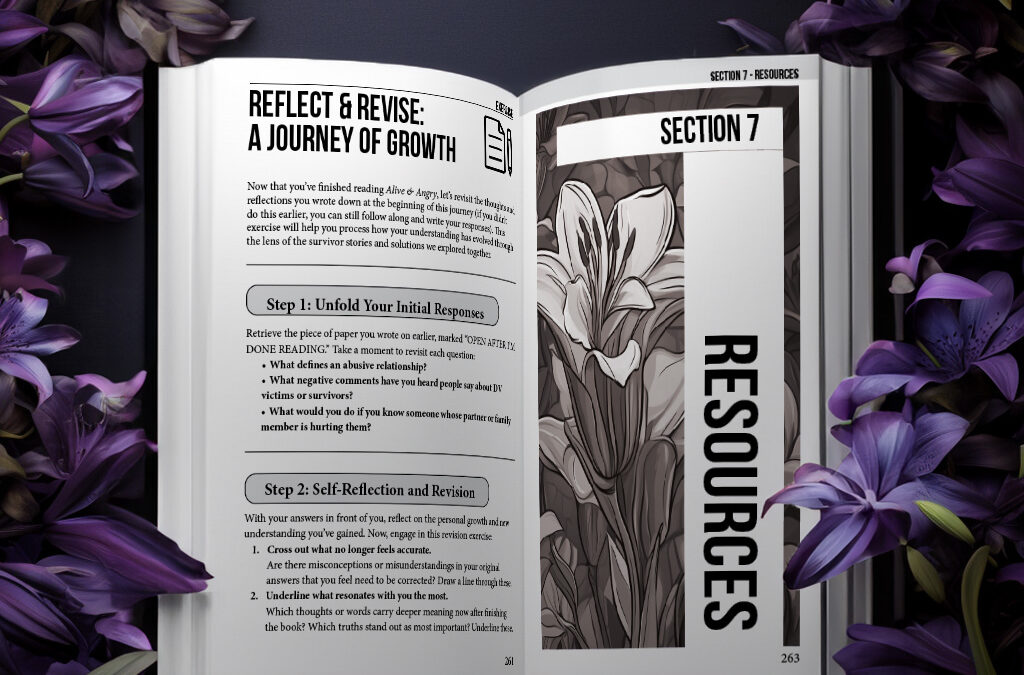Helpful Lists for Domestic Violence Victims
Do you think someone is experiencing domestic abuse, and need to identify the signs?
Do you need help getting out of an abusive relationship?
These resources below can help you or someone you know who might be in a dangerous situation.
More resources can be found in the Resources section of “Alive and Angry“.
15 Common Signs of Domestic Abuse
These signs can vary in intensity and may not all be present in every abusive relationship. Even one or two of these behaviors can indicate a potentially abusive situation.
Here are the most common signs that someone is in an abusive relationship:
- Extreme jealousy and possessiveness
- Controlling behavior, including monitoring activities and restricting contact with friends and family
- Verbal abuse, such as name-calling, insults, and put-downs
- Rapid relationship progression and pressure for commitment
- Unrealistic expectations and demands
- Blame-shifting for problems and feelings
- Hypersensitivity and overreaction to minor issues
- Threats of violence or self-harm
- Physical violence, including pushing, slapping, or hitting
- Financial control and economic abuse
- Intimidation through angry outbursts or destruction of property
- Sexual coercion or pressure
- Gaslighting and manipulation
- Isolation from support system
- Criticism of appearance, decisions, or parenting skills
Citations:
[1] https://www.milligan.edu/wp-content/uploads/2014/09/Warning-Signs-of-Abusive-Behavior.pdf
[2] https://blocked.goodrx.com
[3] https://www.womensaid.ie/what-is-abuse/spotting-the-signs/
[4] https://www.familyplace.org/resource/signs-of-abuse
[5] https://www.thehotline.org/identify-abuse/domestic-abuse-warning-signs/
[6] https://www.reddit.com/r/AskReddit/comments/17qfqvy/what_are_the_signs_your_partner_used_to_be_in_an/
[7] https://www.new-hope.org/warning-signs-of-an-abusive-relationship/
[8] https://www.loveisrespect.org/resources/types-of-abuse/
Domestic Abuse Helplines
Here is a list of the largest domestic abuse helplines by country:
- United States
Organization: National Domestic Violence Hotline
Phone: 1-800-799-7233
Website: www.thehotline.org - Canada
Organization: Assaulted Women’s Helpline
Phone: 1-866-863-0511
Website: www.awhl.org - United Kingdom
Organization: National Domestic Abuse Helpline
Phone: 0808 2000 247
Website: www.nationaldahelpline.org.uk - Australia
Organization: 1800RESPECT
Phone: 1800 737 732
Website: www.1800respect.org.au - New Zealand
Organization: Women’s Refuge
Phone: 0800 733 843
Website: www.womensrefuge.org.nz - Ireland
Organization: Women’s Aid
Phone: 1800 341 900
Website: www.womensaid.ie - India
Organization: National Commission for Women
Phone: 7827170170
Website: www.ncw.nic.in - South Africa
Organization: Stop Gender Violence Helpline
Phone: 0800 150 150
Website: www.genderjustice.org.za - Germany
Organization: Hilfetelefon Gewalt gegen Frauen
Phone: 08000 116 016
Website: www.hilfetelefon.de - France
Organization: Violence Femmes Info
Phone: 3919
Website: www.solidaritefemmes.org
Safe Escape Plan
These steps are designed to help individuals in abusive situations prepare for a safe departure. It is crucial to tailor the plan to your specific circumstances and seek support from local domestic violence resources when possible.
- Assess Your Safety: If you don’t feel safe, avoid breaking up in person. If you must, do it in a public place with someone you trust nearby.
- Trust Your Instincts: Think independently and trust your instincts. Don’t let others pressure you into actions that don’t feel right.
- Establish a Routine: If you live with your partner, maintain a regular routine to help you leave without drawing attention.
- Practice Your Escape: Know the best exits from your home, such as doors, windows, or stairs.
- Prepare an Escape Bag: Have a packed bag ready with essentials like clothes, cash, medications, and important documents (e.g., birth certificates, social security cards, passports).
- Plan Your Route: Know the best route to a safe location. If you have a car, keep the gas tank full; if you rely on public transport, know which options are available.
- Use a Code Word: Establish a code word with trusted people to signal them to call the police if needed.
- Secure Important Documents: Keep copies of important documents like bank account numbers, insurance policies, and legal documents in a safe place.
- Financial Independence: Open a savings account in your name to establish financial independence3.
- Digital Security: Use a safe computer where your internet history can’t be tracked, and consider changing passwords and securing digital accounts.
- Legal and Police Involvement: Consider obtaining a restraining order and notify the police if necessary. Keep emergency contact numbers handy.
- Plan for Pets and Children: Ensure you have a safe plan for your children and pets, including temporary housing options.
- Review and Rehearse Your Plan: Regularly review and practice your escape plan to ensure you are prepared.
